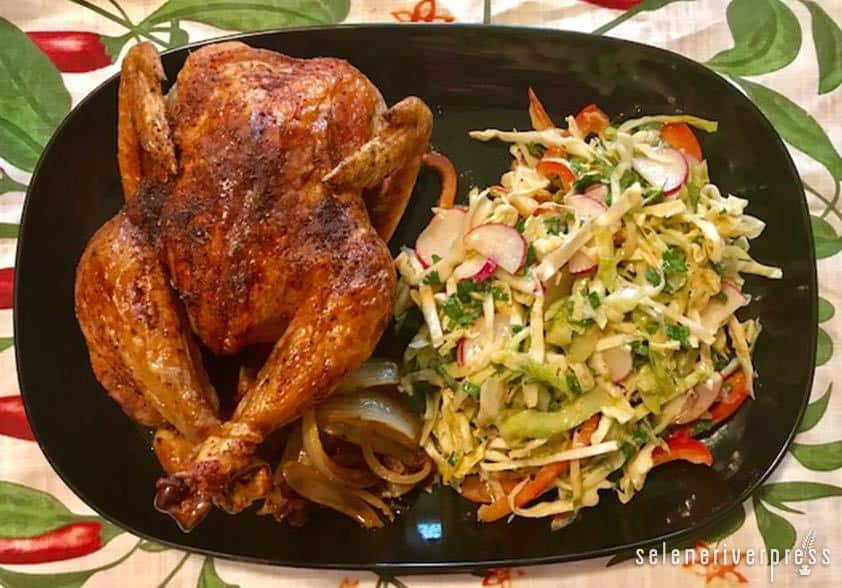Refresh Your Spice Pantry and Your Palate
A well-stocked pantry plays a significant role in preparing healthy, home-cooked meals. It’s also practically indispensable for customizing your meals and keeping your taste buds happy and intrigued. Assorted condiments, vinegars, canned and pickled goods, herbs, and spices can make all the difference in taking your meals to the next level.
Yet no matter how many components you keep stocked, they’re worthless if you don’t feel confident using them.
Spices and herbs are some of the most undervalued ingredients in kitchens. Picture the lowly spice rack (you know the ones I’m talking about) stocked with half-empty jars of tasteless, ancient herbs and spices, all of them gathering dust. Most of them so old they were probably packaged along with the spice rack itself, already devoid of any aroma before they were bottled up. Without quality ingredients to work with, it’s really no surprise that more people don’t feel self-assured enough to experiment freely in the kitchen.
Now, don’t worry. I’m not saying you need to toss your spice rack. However, I would suggest composting anything that came with it and starting fresh. Find ingredients that still contain their fragrant oils (hence, flavor), and watch your cooking go from ho-hum to yum. And don’t forget to save your jars to fill with fresh aromatics.
I’m a huge fan of purchasing bulk herbs and spices. (Mountain Rose Herbs is a reliable source of organic herbs and spices that you can buy in bulk.) Most health food stores, and some general grocery stores, have a bulk section where you can easily dole out just enough of what you need to assure freshness and flavor. Even better, buying herbs and spices in bulk costs mere pennies compared to buying entire jars of the stuff. For me, the bulk section is essential in managing a well-stocked spice collection because I know I won’t be wasting space or dollars on spices I don’t use often but still want handy when do I need them. And because I also use my collection to prepare my own spice blends and marinades, I need to have a range of herbs and spices at the ready.
Don’t get me wrong. I appreciate the ease of premade spice mixes, and I still use them occasionally. But nothing really compares to the blends I make on my own, especially when you consider that many blends on the market contain tons of undesirable ingredients, such as sugars, anti-caking agents, and other harmful additives. Likewise for premade marinades and sauces. When I prepare my own, I know what goes in them, and I can tweak them to my taste. And once again, they cost pennies compared to prepackaged blends. Plus, they’re incredibly easy once you understand the properties of each herb and spice.
One of the first things I explain to people who are new to using spices and other forms of culinary experimentation is the importance of understanding the different flavors they’re working with. Once you become familiar with harmonious flavor groupings and common combinations within different cuisines, you can simply experiment from there by sparingly adding seasonings until you reach the flavor profile you desire. Not all of your trials will work as well as others, but it’s still a surefire way to becoming comfortable with cooking without instructions from a book. As with anything, it becomes easier with time and practice. And before you know it, you’ll be cooking like a pro.
Cajun seasoning is one of the more commonly enjoyed household spice blends, but most every premade Cajun mix includes sugar, free-flowing agents, and additives like MSG. Even many of the recipes for homemade Cajun seasoning that I’ve come across contain sugar, which I find completely unnecessary. Though each recipe is somewhat unique, they usually contain paprika, a blend of herbs and aromatics, and a kick from hot peppers. I tend to make my Cajun blend on the mild side, since I have a kid with aversion to spicy foods, but then I add a little extra heat if I want it spicier.
This recipe highlights the harmonious spices in two ways. First, by rubbing it under and over the skin of the chicken, letting it penetrate the meat as it roasts and creates the most delicious crispy skin. Secondly, when it’s paired with the slaw, the heat from the spice blend is tempered a little from the cool buttermilk and crunchy cabbage. It’s a beautiful match that, in my opinion, needs little more (though a creamy baked yam would be a near-perfect trifecta).
Cajun-Spiced Roast Chicken with Spicy Buttermilk Slaw
Store any leftover spice rub in a jar. For best results, use within six months (if it lasts that long).
Serves 4
Prep time: 30 minutes
Cook time: 1–1½ hours
Ingredients
For the Cajun Spice Rub:
1 tablespoon salt
3 tablespoons paprika
1 teaspoon cracked black pepper
¼–1 teaspoon cayenne pepper
3 teaspoons granulated garlic
1¼ teaspoons granulated onion
1 teaspoon dry oregano
1¼ teaspoons dry thyme
½ teaspoon mustard powder
For the chicken:
1 chicken, about 3½–4 lbs.
Olive oil
Cajun Spice Rub
For the buttermilk slaw:
1 small head green cabbage, cored and thinly sliced
2 ribs celery, thinly sliced
3 green onions, sliced
½ red bell pepper, sliced
3 radishes, sliced
1 small handful parsley, chopped
1 small handful cilantro, chopped
For the dressing:
¼ cup mayonnaise (homemade or good-quality store-bought)
¼ cup sour cream or Greek yogurt
¼ cup buttermilk or kefir
2 tablespoons mild olive oil
2 tablespoons cider vinegar
½ teaspoon Dijon
1 teaspoon Cajun Spice Rub, plus more to taste
1 tablespoon honey (optional)
Instructions
- Combine all ingredients for Cajun Spice Rub in a small bowl. Set aside
- Preheat oven to 375°F. Gently separate skin from chicken breast and around legs. Generously rub spice mix under skin and sprinkle it inside cavity of the chicken. Rub olive oil outside of chicken and season lightly with rub. Roast chicken, basting it occasionally with the pan juices, until crispy and cooked through, about 1¼ hours. Let rest in pan, loosely covered, for 10 minutes before carving
- Meanwhile, prepare buttermilk slaw. Whisk together all dressing ingredients in a small bowl. Set aside. Toss cabbage and remaining ingredients together in a large bowl. Combine slaw with dressing and marinate at least 30–45 minutes in the fridge before serving for best results.
Image from Briana Goodall.


